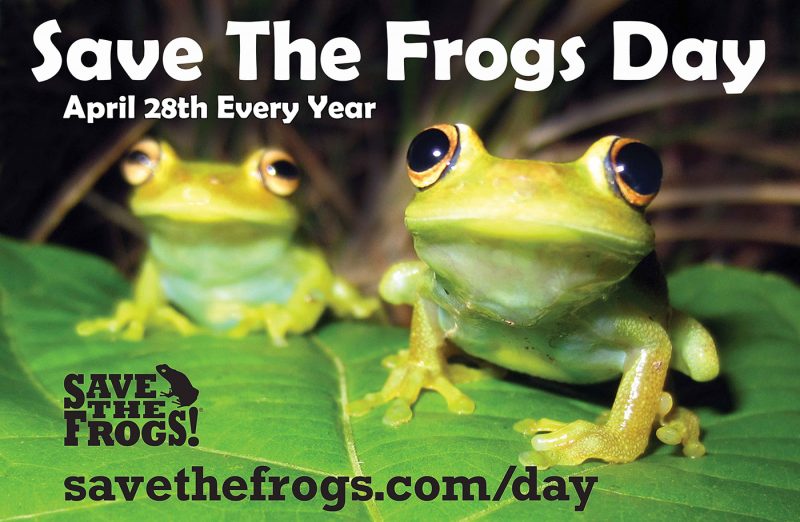
Save the frogs … save the humans?
Our froggy friends are in big trouble and need our help.
The Amphibian Survival Alliance pulls no punches in describing the desperate crisis:
Around half of all amphibian species are declining, and the proportion threatened with extinction is thought to be over 40%, making amphibians the most threatened vertebrate group. Once a sanctuary for over 8,000 species, we now live in a world that is increasingly unsafe for amphibians. A world that is unsafe for amphibians is unsafe for other species, not least humankind.
According to the US Geological Survey (USGS), an “unabated” decline in frog populations – and amphibians in general – began in the U.S. in the 1960s and continues to today. Currently, the number of amphibians in the U.S. is falling at 3.79% annually.
Fixing a global problem requires a worldwide effort. So, this Sunday, April 28, 2024, everyone can – and should – join in during the 16th annual Save the Frogs Day.
All hands on deck to save the amphibians
While the loss of such charismatic creatures is disheartening, the response doesn’t need to be. That’s why in 2008, Kerry Kriger founded the nonprofit Save the Frogs! foundation, sponsor of Save the Frogs Day.
Save The Frogs Day is the world’s largest day of amphibian education and conservation action. Our goal is to provide frog enthusiasts with educational materials, ideas and inspiration and empower them to educate their local communities about amphibians.
Find a 2024 event for April 28; there are opportunities around the world
The foundation’s key event is meant to be fun and solution-oriented. In fact, there have been thousands of past local happenings on Save the Frog Day in 58 different countries. For example, these have included parades, art exhibits, habitat restoration projects and even protests.
Save the Frogs Day has grown in popularity each year, probably because, in the words of late comedian Mitch Hedberg, “frogs are always cool.” And, as Hedberg noted, they inspire enthusiasm:
It’s always optimistic, like, “Hey, here comes that frog! All right! Maybe he will settle near me.”

Reasons for Save the Frogs Day
Frogs and their cousins don’t get the credit they deserve. The froggy foundation says they make a genuine contribution to the quality of human existence.
Amphibians provide an array of ecosystem services, and knowledge of amphibians has led to numerous advances in human medicine. Plus frogs look and sound cool, and kids love them …
One of the “ecosystem services” frogs are famous for is eating bugs, especially flying insects. That means when amphibian populations bomb, their prey species, like mosquitoes, can boom.
A study published in September 2022 in the peer-reviewed journal Environmental Research Letters described the aftermath of mass amphibian die-offs due to a fungal infection in Central America. Loss of amphibians, researchers discovered, correlated directly with a rise in cases of deadly malaria.
This wave traveled from northwest to southeast across Costa Rica from the early 1980s to the mid-1990s and then continued eastward across Panama through the 2000s. After this rolling collapse of amphibian populations, both countries experienced large increases in malaria cases.
The fungus attacking amphibians is chytridiomycosis. And it’s spreading around the globe. Amphibiaweb described the fungal disease as the current greatest danger to amphibians:
The causes for recent amphibian declines are many, but an emerging disease called chytridiomycosis and global climate change are thought the be the biggest threats to amphibians. Chytridiomycosis is a disease caused by the fungal chytrid pathogen Batrachochytrium dendrobatidis (Bd). This pathogen is associated with the global loss of hundreds of species of amphibians and represents a spectacular loss of biodiversity, some say the worst in recorded history.
Bd has spread to all inhabited continents, likely due to human-caused contamination occurring in the global frog trade.
Find a 2024 event for April 28; there are opportunities around the world
Amphibians are a canary in a coal mine
While the USGS agrees disease and climate change are leading drivers of the decline in amphibian populations, other factors are also working against our cute but slimy little friends. Climate change plays the most significant role in the southern U.S. and West Coast. But elsewhere loss of habitat is driving the wave of extinction. Also, pesticides can be particularly deadly to amphibians. As the USGS said:
Amphibians, unlike people, breathe at least partly through their skin, which is constantly exposed to everything in their environment. Consequently, their bodies are much more sensitive to environmental factors such as disease, pollution, toxic chemicals, ultraviolet radiation and habitat destruction. The worldwide occurrences of amphibian declines and deformities could be an early warning that some of our ecosystems, even seemingly pristine ones, are seriously out of balance.
The USGS considers the decline of amphibian species to be damaging to ecosystems and biodiversity. To track the unfolding and troubling story of the amphibian die-off, and to provide information and guidance aimed at improving the situation, the USGS has established the Amphibian Research and Monitoring Initiative.
Check out Amphibiaweb’s resource page for more information on amphibians and how to help them survive.
Bottom line: Save the Frogs Day – a yearly, global amphibian conservation effort – is today, Sunday, April 28, 2024. Amphibian health is an important marker of overall ecosystem quality.
Find a 2024 event for April 28; there are opportunities around the world











